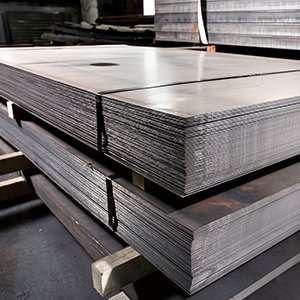Type 317 (UNS S31700/1.4449)
● Austenitic standard stainless-steel.
● Resistant to general/ pitting/ crevice corrosion.
● Higher creep and tensile strength.
● Fabricable, formable and weldable.
Description
With 3-4% molybdenum, Type 317 of stainless steel is an austenitic chromium-nickel steel alloy with compound substances higher than the 316 evaluation types. The higher concentration of molybdenum greatly improves Type 317 resistance to pitting and crevice corrosion. Along with resistance to corrosion, Type 317 also offers high tensile and creep strength properties at elevated temperatures.
Type 317 stainless steel is able to stand against attacks from sulphurous, acetic, formic, citric and tartaric acids and resist to pitting due to phosphorous acid, chlorides, bromides and iodides This makes it an ideal choice of steel grade in projects and situations where the environment requires stainless steel with higher corrosion resistance from chemical interactions, industrial pollution or excessive salt exposure.
Common names: 317 Stainless, Chromium-Nickel steel
Executive standards:
- AISI 317
- UNS S31700
- JIS SUS317
- ASTM A167, ASTM A182, ASTM A213, ASTM A240, ASTM A249, ASTM A269, ASTM A276, ASTM A312, ASTM A314, ASTM A403, ASTM A409, ASTM A473, ASTM A478, ASTM A511, ASTM A554, ASTM A580, ASTM A632, ASTM A813, ASTM A814
- DIN 1.4449
- GB S31708
- EN 1.4445()
- QQ S763
- ASME SA403, SA409, SA312, SA249, SA240,
- SAE 30317,
- MIL-S-862
Chemical Properties:
| Element | Maximum percentage |
| Carbon | 0.08 |
| Molybdenum | 3-4 |
| Manganese | 2 |
| Nickel | 11-15 |
| Chromium | 18-20 |
| Phosphorus | 0.045 |
| Sulphur | 0.03 |
| Silicon | 1 |
Mechanical Properties:
| Property (Annealed Sheet) | Value | |
| Tensile Strength | ksi | 90 |
| MPa | 621 | |
| Yield Strength
(0.2% offset) |
ksi | 40 |
| MPa | 276 | |
| Elongation in 2” (50.80) % | 45 | |
| Hardness (Rockwell) | B85 | |
Physical Properties:
| Property | Value |
| Density (lb / cu. in.) | 0.29 |
| Specific Heat (Btu/lb/Deg F – [32-212 Deg F]) | 0.12 |
| Specific Gravity | 7.9 |
| Electrical Resistivity (microhm-cm (at 68 Deg F)) | 444 |
| Melting Point (Deg F) | 2550 |
| Modulus of Elasticity Tension 28 | 28 |
Key Features:
- Better corrosion resistance compared to type 316 under the same environment.
- Type 317 has higher anxiety to crack and resistances than other stainless steels.
- Has lower intergranular precipitation of chromium carbides during welding.
- Type 317 stainless steel is non-magnetic in the annealed condition.
- Ability to withstand chemical attacks from tartaric acids, sulphurous, acetic, citric, and formic.
Product Forms Available:
Sheet, strip, plate, round bar, flat bar, pipe, tube, fitting, flange, fastener, forging stock, hexagon and wire.
Applications:
Type 317 and higher grades are used (not restricted to) in;
- Textile machinery
- Pulp and paper plant equipment
- Pollution control equipment
- Chemical and petrochemical processing equipment
- Storage tanks
- Chemical processing tanks
- Pharmaceutical vessels
Possible Alternative Grades:
Possible alternative grades to Type 317 are Type 317L, Type 317LM, and Type 317LMN
- Type 317L: Offers increased creep, tensile strength, and stress-to-rupture at increased temperatures (≤0.08)
Type 317LM: The best chloride resistance of the 300 series and offers better corrosion resistance - Type 317LMN: Prevents chromium carbide precipitation during stress-relieving and welding. It is also used where weldability and strength are critical.
FAQs:
- Is type 317 stainless steel better than Type 316?
Yes. Although both the types offer corrosion resistance, Type 317 has more than 3% molybdenum which significantly higher resistance to pitting and crevice corrosion at ambient temperatures.
- Does Type 317 and 317L mean the same type of stainless steel?
No. Type 317L has a slightly different chemical composition then Type 317 as it has lower carbon. This enables it to produce stronger welds then Type 317 with same high strength and corrosion resistance as type 317.
- Does Type 317 offer resistance to acidic chemicals?
Yes. Type 317 stainless steel able to resist chemical attacks from a range of acids such as sulphurous, acetic, formic, citric and tartaric. Due to this property, Type 317 is used for chemical and petrochemical processing equipment and storage tanks.
Get A Free Quote Now!







